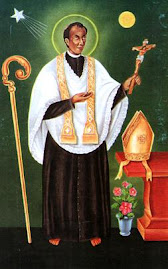BLESSED JOSEPH VAZ
The Missionary of Asia, Ambassador of Peace, Apostle of Sri Lanka and
Patron Of The Archdiocese Of Goa & Daman
Blessed Joseph Vaz was born in Goa on
April 21, 1651, in the house of his maternal grandparents at Benaulim and was
raised in his father's house at Sancoale. From a very young age, Joseph revealed an
extraordinary inclination to a life of communion with God, which led him to
seek admission in the seminary of what is now Old Goa.
He was ordained priest in 1674. Very soon he became known as a compelling preacher and
retreat master, besides being confessor and spiritual guide to many a prominent
Portuguese citizen in the city of Goa, including two Governors. This was, indeed, a rare honor accorded to a native
priest! Taking
into account his rare qualities of mind and heart, the Diocesan Authority of
Goa appointed him Vicar Forane of Canara (Karanataka) in 1681. Here he evolved such a gigantic pastoral and social
action, that it earned him, many years after his death, the title of Apostle of
Canara and Ceylon.
In the meantime, the Catholic Church in
Sri Lanka was going through a great struggle for survival. It had been a flourishing Church, tended by Portuguese
missionaries for over a century and a half, till 1658, when Sri Lanka was
conquered by Dutch Calvinists. The new invaders set out to systematically suppress
Catholicism in the land. Catholics in their thousands succumbed to the fierce
persecution, while others, left without priest and sacraments, heroically
remained faithful to the Church, amidst all the hardships.
Having heard about the plight of the
Catholic Church in Sri Lanka, Joseph Vaz is fired by an apostolic zeal to go to
its rescue. Before
that, however, he joins a group of Goan priests who were trying to form a
Religious Congregation. Very soon, recognizing his sanctity and seasoned
missionary experience, these priests elect him their Superior. He becomes thus, in 1685, the Founder of India's first
fully native Religious Congregation: the Oratory of St. Philip Neri of Goa. The Congregation died a natural death when religious
orders were suppressed in 1835.
In 1687 Joseph Vaz, disguised as a porter
and accompanied by his faithful domestic servant John, landed in Sri Lanka. In
nine months' time, he visited the entire island, contacted all the Catholic
settlements and strengthened the faithful in their religious practice. Day after day, month after harrowing month, year after
persecution-ridden year, Joseph Vaz re-built the crumbling edifice of the
Catholic Church in Sri Lanka.
Only nine years later was he joined by two Oratorian
priests sent from Goa? Through the next fifteen years, their number rose to
ten. When
Joseph Vaz died, after 24 years of indefatigable missionary activity in Sri
Lanka, fifteen big churches, two hundred chapels and another two hundred
schools and hospitals had been built across the great island. The Catholic Church became seventy thousand strong,
some 40% being converts from other faiths. It was the story of a Church, which rose from ashes to
glory. The
great Apostle of Sri Lanka built a Church deeply rooted in the local culture,
made use of vernacular language and music in the liturgy, dressed himself like
a true sanyasi that he was steeped in prayer, penance and poverty -- founded
small Christian communities and entrusted them to well formed, mature lay
leaders. He
was thus a pioneer in the modern methods of evangelization.
Joseph Vaz was beatified by Pope John Paul
II in Sri Lanka, on 21st January 1995. He was proclaimed Patron of the Archdiocese of Goa and
Daman by Archbishop-Patriarch Raul Gonsalves-Patriarch Raul Gonsalves on 16th
January 2000: the 289th anniversary of his death.



